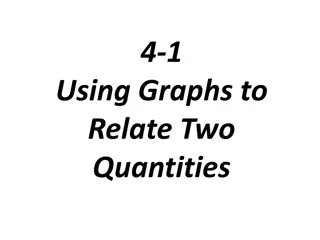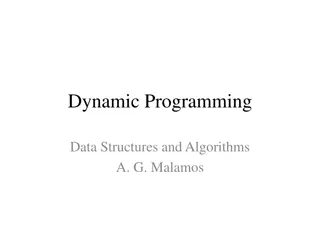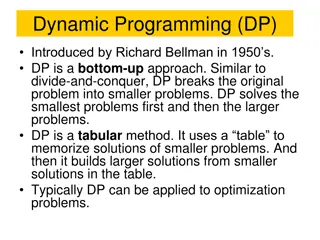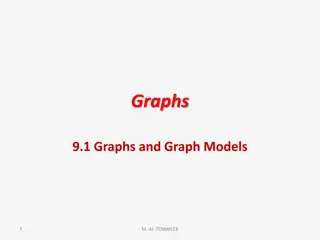Understanding Bellman-Ford and Dynamic Programming on Graphs
Exploring Bellman-Ford and Floyd-Warshall algorithms, Dijkstra's Algorithm, shortest path problems, dynamic programming on graphs, and solving distances in a directed acyclic graph. Learn about recurrences, evaluation orders, topological sort, and handling cycles in graphs.
Download Presentation

Please find below an Image/Link to download the presentation.
The content on the website is provided AS IS for your information and personal use only. It may not be sold, licensed, or shared on other websites without obtaining consent from the author. Download presentation by click this link. If you encounter any issues during the download, it is possible that the publisher has removed the file from their server.
E N D
Presentation Transcript
Bellman-Ford CSE 417 Winter 21 Lecture 15
Today Dynamic Programming on Graphs We re building up to Bellman-Ford and Floyd-Warshall Two very clever algorithms we won t ask you to be as clever. But they re standard library functions, so it s good to know. And deriving them together is good for practicing DP skills.
Shortest Paths Shortest Path Problem Given: A directed graph and a vertex ? Find: The length of the shortest path from ? to ?. The length of a path is the sum of the edge weights. Baseline: Dijkstra s Algorithm
Dijkstras Algorithm Dijkstra(Graph G, Vertex source) initialize distances to mark source as distance 0 mark all vertices unprocessed while(there are unprocessed vertices){ let u be the closest unprocessed vertex foreach(edge (u,v) leaving u){ if(u.dist+weight(u,v) < v.dist){ v.dist = u.dist+weight(u,v) v.predecessor = u } } mark u as processed } In 373, we said the running time was ?(?log? + ?log?) Can be sped up to ? ? + ?log? by inserting a different heap implementation.
A recurrence Suppose you have a directed acyclic graph ?. How could you find distances from ?? What s one step in this problem?
A recurrence Suppose you have a directed acyclic graph ?. How could you find distances from ?? What s one step in this problem? Choosing the predecessor, i.e. the last edge on a path.
A recurrence ???? ? = 0 if ? is the source min ?: ?,? ????? ? + ???? ? ?,? otherwise Our memoization structure can be the graph itself. What s an evaluation order? (Remember we re in a DAG!)
A recurrence ???? ? = 0 if ? is the source min ?: ?,? ????? ? + ???? ? ?,? otherwise Our memoization structure can be the graph itself. What s an evaluation order? (Remember we re in a DAG!) A topological sort! we need to have distances for all incoming edges calculated.
What about cycles? ???? ? = 0 if ? is the source min ?: ?,? ????? ? + ???? ? ?,? otherwise 6 5 3 3 2 1 8 4
Cycles We need some way to order the paths. I.e. we need to be sure we always have something It doesn t have to be the perfect distance necessarily As long as we ll realize it and update later something to look up. And as long as we can fix it to the true distance eventually.
Ordering Instead of ????(?), (the true distance) right from the start, we ll let ????(?,?) to be the length of the shortest path from the source to ? that uses at most ? edges. That breaks ties counting the number of edges required! ???? ?,? =
Distances 6 5 3 v 3 2 s 1 8 4 ???? ?,2 = (can t get there in 2 hops) ???? ?,3 = 14 ???? ?,4 = 12
Ordering Instead of ????(?), (the true distance) right from the start, we ll let ????(?,?) to be the length of the shortest path from the source to ? that uses at most ? edges. That breaks ties counting the number of edges required! ???? ?,? =
Ordering Instead of ????(?), we want the ????(?,?) to be the length of the shortest path from the source to ? that uses at most ? edges. 0 min min ?: ?,? ????? ?,? 1 if ? = 0 and ? is the source if ? = 0 and ? is not the source + ?(?,?),???? ?,? 1 ???? ?,? = o/w
Sample calculation 6 5 a 3 c v 3 2 s 1 b d 8 4 Vertex\? S A B C D V 0 0 1 0 3 8 2 0 3 8 9 3 0 3 8 9 11 14 4 0 3 8 9 11 12 5 0 3 8 9 11 12
Pseudocode Initialize source.dist[0]=0, u.dist[0]= for others for(i from 1 to ??) for(every vertex v) //what order? v.dist[i] = v.dist[i-1] for(each incoming edge (u,v))//hmmm if(u.dist[i-1]+weight(u,v)<v.dist[i]) v.dist[i]=u.dist[i-1]+weight(u,v) endIf endFor endFor endFor ???? ?,? = min min ?: ?,? ????? ?,? 1 0 if ? = 0 and ? is the source if ? = 0 and ? is not the source + ?(?,?),???? ?,? 1
Pseudocode Initialize source.dist[0]=0, u.dist[0]= for others for(i from 1 to n-1) for(every vertex v) //what order? v.dist[i] = v.dist[i-1] for(each incoming edge (u,v))//hmmm if(u.dist[i-1]+weight(u,v)<v.dist[i]) v.dist[i]=u.dist[i-1]+weight(u,v) endIf endFor endFor endFor The shortest path will never need more than ? 1 edges (more than that and you ve got a cycle)
Pseudocode Only ever need values from the last iteration Order doesn t matter!! Initialize source.dist[0]=0, u.dist= for others for(i from 1 to n-1) for(every vertex v) //what order? v.dist[i] = v.dist[i-1] for(each incoming edge (u,v))//hmmm if(u.dist[i-1]+weight(u,v)<v.dist[i]) v.dist[i]=u.dist[i-1]+weight(u,v) endIf endFor endFor endFor
Pseudocode Initialize source.dist[0]=0, u.dist[0]= for others for(i from 1 to n-1) for(every vertex v) //any order v.dist[i] = v.dist[i-1] for(each incoming edge (u,v))//hmmm if(u.dist[i-1]+weight(u,v)<v.dist[i]) v.dist[i]=u.dist[i-1]+weight(u,v) endIf endFor endFor endFor Graphs don t usually have easy access to their incoming edges (just the outgoing ones)
Pseudocode Initialize source.dist[0]=0, u.dist[0]= for others for(i from 1 to n-1) for(every vertex v) //any order v.dist[i] = v.dist[i-1] for(each incoming edge (u,v))//hmmm if(u.dist[i-1]+weight(u,v)<v.dist[i]) v.dist[i]=u.dist[i-1]+weight(u,v) endIf endFor endFor endFor So if we only have access to outgoing edges But the order doesn t matter as long as we check every edge, the processing order is irrelevant.
Pseudocode Initialize source.dist[0]=0, u.dist[0]= for others for(i from 1 to n-1) set u.dist[i] to u.dist[i-1] for every u for(every vertex u) //any order for(each outgoing edge (u,v))//better! if(u.dist[i-1]+weight(u,v)<v.dist[i]) v.dist[i]=u.dist[i-1]+weight(u,v) endIf endFor endFor endFor
Pseudocode Initialize source.dist[0]=0, u.dist[0]= for others for(i from 1 to n-1) set u.dist[i] to u.dist[i-1] for every u for(every vertex u) //any order for(each outgoing edge (u,v))//better! if(u.dist[i-1]+weight(u,v)<v.dist[i]) v.dist[i]=u.dist[i-1]+weight(u,v) endIf endFor endFor endFor We don t really need all the different values Just the most recent value.
Pseudocode Initialize source.dist=0, u.dist= for others for(i from 1 to n-1) set u.dist[i] to u.dist[i-1] for every u for(every vertex u) //any order for(each outgoing edge (u,v))//better! if(u.dist+weight(u,v)<v.dist) v.dist=u.dist+weight(u,v) endIf endFor endFor endFor We don t really need all the different values Just the most recent value.
Pseudocode Initialize source.dist=0, u.dist= for others for(i from 1 to n-1) for(every vertex u) //any order for(each outgoing edge (u,v))//better! if(u.dist+weight(u,v)<v.dist) v.dist=u.dist+weight(u,v) endIf endFor endFor endFor We don t really need all the different values Just the most recent value.
A Caution We did change the code when we got rid of the indexing You might have a mix of dist[i],dist[i+1],dist[i+2], at the same time. That s ok! You ll only override a value with a better one. And you ll eventually get to ????(?,? 1) After iteration ?, ? stores ????(?,?) for some ? ?.
Exit early If you made it through an entire iteration of the outermost loop and don t update any ????() Then you won t do any more updates in the next iteration either. You can exit early. More ideas to save constant factors on Wikipedia (or the textbook)
Laundry List of shortest pairs (so far) Algorithm BFS Running Time ?(? + ?) Special Case ONLY unweighted graphs ONLY for DAGs Negative edges? X Simple DP Dijkstra s Bellman-Ford X X ??? ?(? + ?) ?(? + ?log?) ?(??)
Pseudocode Initialize source.dist=0, u.dist= for others for(i from 1 to n-1) for(every vertex u) //any order for(each outgoing edge (u,v))//better! if(u.dist+weight(u,v)<v.dist) v.dist=u.dist+weight(u,v) endIf endFor endFor endFor What happens if there s a negative cycle?
Negative Edges Negative Cycles 6 Negative edges, but only non- negative cycles a 6 a 5 c e 5 c e 3 2 3 2 1 b d 1 b d -8 The fastest way from ? to ? (i.e. least-weight walk) isn t defined! No valid answer ( ) -3 Dijkstra s might fail But the shortest path IS defined. There is an answer
Fill out the poll everywhere for Activity Credit! Go to pollev.com/cse417 and login with your UW identity Negative Cycle 6 5 a 3 c v 3 -8 s 1 b d 8 4 Vertex\? S A B C D V 0 0 1 0 3 8 2 0 3 8 9 3 0 3 8 9 1 14 4 0 3 5 9 1 2 5 6
Laundry List of shortest pairs (so far) Algorithm BFS Running Time ?(? + ?) Special Case only Negative edges? ONLY unweighted graphs ONLY for DAGs X Simple DP Dijkstra s Bellman-Ford X X Yes! ?(? + ?) ?(? + ?log?) ?(??)
All Pairs For Dijkstra s or Bellman-Ford we got the distances from the source to every vertex. What if we want the distances from every vertex to every other vertex?
Another Recurrence ???? ? = 0 if ? is the source min ?: ?,? ????? ? + ???? ? ?,? otherwise Another clever way to order paths. Put the vertices in some (arbitrary) order 1,2, ,? Let ????(?,?,?) be the distance from ? to ? where the only intermediate nodes are 1,2, ,? intermediate
Another Recurrence Put the vertices in some (arbitrary) order 1,2, ,? Let ????(?,?,?) be the distance from ? to ? where the only intermediate nodes are 1,2, ,? intermediate ???? ? ?,? 0 min dist ?,?,? 1 + dist ?,?,? 1 ,dist(?,?,? 1) otherwise if ? = 0,(?,?) exists if ? = 0,? = ? if ? = 0, no edge (?,?) dist ?,?,? =
Pseudocode dist[][] = new int[n-1][n-1] for(int i=0; i<n; i++) for(int j=0; j<n; j++) dist[i][j] = edge(i,j) ? weight(i,j) : for(int i=0; i<n; i++) dist[i][i] = 0 for every vertex ? for every vertex ? for every vertex ? if(dist[u][r] + dist[r][v] < dist[u][v]) dist[u][v]=dist[u][r] + dist[r][v] standard form of the Floyd-Warshall algorithm. Similar to Bellman-Ford, you can get rid of the last entry of the recurrence (only need 2D array, not 3D array).
Running Time ? ?3 How does that compare to Dijkstra s?
Running Time If you really want all-pairs Could run Dijkstra s ?times ?(??log? + ?2log?) If ? ?2 then Floyd-Warshall is faster! Floyd-Warshall also handles negative weight edges. Ask Robbie after how to detect them.
Takeaways Some clever dynamic programming on graphs. Which library to use? Need just one source? Dijkstra s if no negative edge weights. Bellman-Ford if negative edges. Need all sources? Flord-Warshall if negative edges or ? ?2 Repeated Dijkstra s otherwise

 undefined
undefined

























